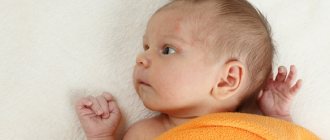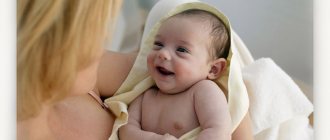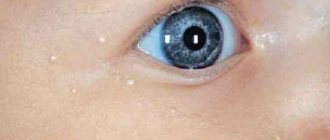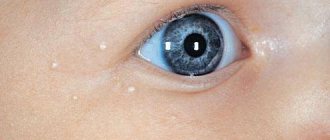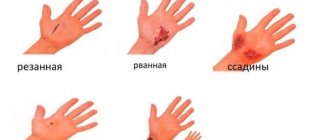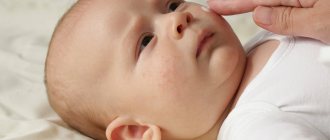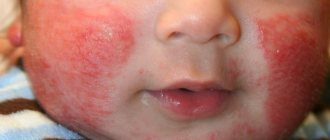Causes
On their own, at home, it will be very difficult for parents to determine why red pimples broke out on their child’s body. They can only analyze their baby’s lifestyle and menu, which may cause this irritation. If the reason lies in malfunctions and disruptions in the functioning of various systems of a small body, it is better to consult a doctor as soon as possible for a timely diagnosis. Among the factors that provoke the appearance of a rash are:
- teething (accompanied by copious salivation);
- diaper rash;
- reaction to vaccination;
- failure to comply with basic hygiene rules;
- low-quality clothing made from synthetic materials;
- overheating of the skin (if too many things are put on the baby and he becomes hot), resulting in prickly heat (in the hospital, such pimples are called milliaria);
- allergies (it is necessary to identify what the baby reacts to so violently in order to exclude his contact with this object or animal);
- diseases such as scarlet fever (accompanied by fever), chickenpox (fever), measles (a cough is added to the rash);
- streptoderma;
- infectious inflammation of the skin;
- dyshidrosis;
- molluscum contagiosum;
- enterovirus;
- external environmental factors: chapping, sunburn or frostbite, insect bites;
- acneiform rash in infants whose mother took certain medications during pregnancy: steroids, medications with lithium or phenytoin.
If you notice red pimples on your child's face, tummy and other parts of the body, try to understand why this could be happening. If there are no obvious reasons, be sure to seek medical help at the hospital. After all, treatment will most directly depend on what kind of rash covers your baby’s body.
The reason for their appearance
The skin of a newborn produces a lot of oily substances, which is why crusts form on the eyebrows, head and even ears. If microbes get on these formations, they become compacted and become difficult to get rid of. They do not pose any danger to the child’s health and do not cause discomfort, since the child does not feel them.
Appearing on the head, the scales can connect with each other. They are greasy and stick to the hair.
Crusts on the face prevent the skin from breathing and receiving oxygen in full. As a result, inflammation may occur. In this case, the child will experience pain, burning, and itching. In addition, any violation of the skin on the face looks unaesthetic, and mothers try with all their might to get rid of them.
In determining the causes of skin manifestations on the head, eyebrows and other parts of the body, the age of the baby is important.
- If scales appear immediately after childbirth, the cause may be the mother’s hormones. When they enter the child’s body in utero, they cause increased activity of the sebaceous glands. Over the course of several weeks, the baby's body will be freed from them.
- The appearance of crusts on the face, eyebrows, and head in a later period may be associated with an allergic reaction of the body. As a result, seborrheic dermatitis occurs. In breastfed children, allergic manifestations depend on the mother's food. You should stick to a diet and exclude fatty, spicy and sweet foods from your diet. Synthetic clothing or cosmetics can act as an irritant.
- Seborrheic dermatitis occurs due to the appearance of yeast and fungi in the skin.
- A yellow crust indicates an overabundance of cosmetics (milk, cream) or a lack of hygiene procedures.
- Less commonly, the cause may be a weakened immune system, stress, oily skin or skin diseases.
Crusts on the head may appear due to either frequent shampooing, or if it is not suitable. You should wash your hair with plain water without using cosmetics.
If you follow all the rules of hygiene, and the condition only worsens, then you need to consult a doctor as soon as possible.
Perhaps the cause of the trouble lies in infection with Staphylococcus aureus. What is this? This is a bacterium that belongs to the opportunistic microflora. Most people are carriers of it. But with normal functioning of the immune system and compliance with hygiene rules, the bacterium is not dangerous.
If hygiene rules are not followed and immunity is weakened, bacteria begin to quickly multiply and spread to other parts of the body. They can cause a lot of trouble later. For example, purulent sore throat or meningitis.
In order to confirm that Staphylococcus aureus is the cause of the appearance of crusts behind the ears of a baby, you need to take a microflora culture.
If severe irritation is accompanied by a symptom such as a high temperature, then you need to urgently call a doctor! In this case, the doctor will prescribe antibiotic therapy to stop the infection.
Do not self-medicate with folk remedies. They won't help here, and you'll waste valuable time. Any lotions with herbal infusions can only aggravate the situation, since organic products create a breeding ground for bacteria.
Types of rash
Red pimples that appear in a child on the face (most often on the cheeks and around the mouth) and on the body (on the arms and legs, on the butt, on the back, on the stomach) may look different. For some, they may present as localized lesions that resolve within a few days. In others, they can cover most of the body and over time only grow and become even more inflamed. These may be rashes such as:
- small pale red pimples on the chin, gradually turning into one continuous inflamed spot - this is due to excessive salivation during teething;
- red, watery pimples on a child’s body can be a symptom of chickenpox: at first, single tumors become more and more numerous;
- pimples on the butt - from diaper rash due to a diaper;
- if a black dot can be seen in the center of the water pimples, molluscum contagiosum will most likely be diagnosed;
- pimples mainly spread exclusively to the arms (palms) and legs (feet) of the baby and appear in the off-season (spring and autumn) - we are talking about dyshidrosis;
- a pink-red spot, which after a few hours turns into watery pimples, is a sign of streptoderma;
- small red pimples on a child’s body are heat rash due to lack of fresh air for the skin.
To avoid complications, the diagnosis must be carried out by a doctor, even if at first it seems to you that the red pimples on your child’s body are about to go away on their own. And even more so, you should not self-medicate, which will only worsen the situation. Qualified medical care is what your baby needs in this situation.
How to treat
The main treatment for rashes on a child’s body is to treat the underlying disease that caused them. In parallel with this, external medications are prescribed in order to somehow alleviate the itching, burning sensation and prevent the formation of ulcers in the future. Drug treatment involves prescribing the following drugs.
- Bepanten cream and powder if the cause of pimples is diaper rash.
- Bathing in a weak solution of potassium permanganate. The doctor may instead recommend adding decoctions of anti-inflammatory medicinal herbs to the bath - chamomile, string, calendula, oak bark, etc.
- If pimples are caused by an allergy to some food product, a special diet will be prescribed for the mother if the baby is breastfed, or for the baby himself if he is “artificial.”
- Washing and wiping pimples on the child’s body with a solution of furatsilin.
- Antihistamines.
- If we are talking about scarlet fever, antibiotics may be prescribed.
- Zelenka and antipyretics are prescribed for chickenpox.
- In order for the skin to recover faster after pimples, vitamin therapy is carried out.
- If the situation is too serious, doctors may decide to hospitalize the baby.
If everything is done in a timely manner, competently, in accordance with the recommendations of doctors, you can speed up the baby’s recovery without any side effects or complications. Parents should always remember that the baby’s skin is an indicator of his health, so any pimples on it should be treated immediately, finding out their cause and eliminating it. New articles We are on social networks
up
Infants are under special control and attention from adults. Any changes in behavior and health in most cases become noticeable immediately, especially if it is related to the face. Pimples on the face of a baby are not uncommon.
Treatment of scrofula behind the ears in children
Children from birth to 10 years of age may suffer from a specific type of atopic dermatitis, which is colloquially called “scrofula.” Crusts behind a child’s ears, which arise as a result of the disease, bring unpleasant and painful sensations. When an adult removes them, pink skin appears underneath, as if burned. The formation resembles a weeping wound.
Consult your doctor for a diagnosis. He will prescribe treatment. It is usually aimed at local lesions. Therapy consists of using zinc ointment and cauterizing the wounds with fucorcin. Bepanten ointment helps a lot. The child should be bathed with a decoction of currant leaves added to the bath.
Also, the pediatrician will most likely prescribe procedures and medications that are aimed at strengthening the immune system. Doctors recommend that children over the age of one year take fish oil. If a mother is breastfeeding, she can take this supplement herself. The baby will receive it along with milk.
Causes of skin changes not caused by disease
Small pimples may appear on the head, under the eyes or in other parts of the body already in the maternity hospital. In the first month, such rashes go away on their own.
- Most often, red or white small pimples can appear in the first month in infants on the head or face. Children fed with breast milk receive hormones from their mother, which cause skin changes.
- An allergic reaction to components of the mother's diet if the child is breastfed. The appearance of pimples can be caused by an incorrectly selected mixture or improper dilution during artificial feeding.
- Perhaps this is a skin reaction to climate change.
- Red formations on the skin may be a sign of heat rash. Often a child is dressed too warmly at home and outside.
- Skin reaction to frost and wind.
- Use of cosmetics.
- Disorders of the intestines (for example, dysbiosis).
Diseases that are accompanied by skin rashes
Pimples on a baby's head, neck or face may indicate an infection (measles, scarlet fever) in the body. The main symptoms include a deterioration in the child’s well-being—fever, poor appetite.
During measles, small pimples appear that gradually spread throughout the body. On the first day of the disease, red rashes appear on the neck and face. In the following days, other parts of the body are covered.
During chickenpox, red pimples appear not only on the face, but also on the head.
The rash spreads throughout the body, accompanied by fever and other symptoms (cough, runny nose).
With such a serious disease as meningitis, red pimples may appear throughout the body, which are connected to each other. This indicates the spread of the virus. The child feels unwell, lethargic, and the temperature rises.
White, red and colorless pimples can appear with serious diseases such as rubella, eczema and herpes. Therefore, you should not take a wait-and-see attitude, but seek help from a specialist.
Types of skin rashes
Pimples can vary in color, extent of distribution and size.
White pimples are usually not inflammatory in nature - they are small, isolated rashes. In the center of each pimple there is white content. They may appear as early as the first month of birth.
Most often, white pimples are localized on the forehead, chin, cheeks, and under the eyes.
White pimples can occur due to:
- influence of mother's hormones;
- adaptation of the child to new conditions;
- immaturity of the sebaceous glands;
- allergies to food or clothing.
As the child grows, sebaceous ducts form and the white pimples disappear on their own. There are no scars or wounds left in their place.
Usually white rashes do not cause pain, do not itch or bother the baby. They go away on their own by the age of two months.
Red rashes on the face, neck and under the eyes occur most often in infants. In most cases, they do not cause discomfort, but they should be treated immediately upon discovery. Only a doctor will prescribe correct and adequate treatment.
Red pimples may appear for the following reasons:
- Diathesis. Allergens can include household chemicals, food, pets, and feathers.
- Hormonal changes in the body (acne appears on the neck, cheeks). In the center of each pimple, purulent contents may be observed.
- Excessive wrapping leads to excessive sweating, which leads to skin changes.
Diathesis is a very common occurrence among infants. The rash that appears with this disease is itchy. The child constantly touches his face and sleeps poorly.
If the child is not properly cared for, pimples may also appear on the head.
Therapeutic measures
In some cases, acne in infants does not require special treatment and goes away on its own within a few days after it occurs. If this does not happen, you should not self-medicate - you need to consult a pediatrician. Based on the initial examination, he will decide on additional examination methods or refer you for consultation to other specialists. You may need to be examined by a gastroenterologist, allergist, or dermatologist.
What parents need to do
- Wet the rash areas as little as possible.
- The first month you need to boil water for all water procedures. It should be cooled to the required temperature before use.
- Do not use cosmetics or allow them to come into contact with the damaged area of the skin.
- You can make decoctions from medicinal herbs (chamomile, string). Lotions from such decoctions will help relieve inflammation, itching and swelling. Moreover, with anti-inflammatory and antimicrobial properties, the herbs can stop the spread of pimples on the face.
- Do not use alcohol-based solutions or lotions.
Without consulting with specialists and taking a number of measures, you should not use antihistamines and hormonal drugs.
All actions to treat pimples on a baby’s face should be carried out carefully, without unnecessary pressure or friction.
Rash in a child with prominent areas
Hives. Hives are an allergic reaction. It appears as prominent patches of red skin that cause itching. Baths can help, as after them the body stops reacting to the allergen. If your baby has trouble breathing or there is excessive swelling, you should seek immediate medical attention .
Hives may appear in one area of the skin, and small, itchy red blisters may appear - this is usually a sign of an allergic reaction. The blisters may appear as a rash without large areas. This is usually a skin reaction after contact with an irritant. It could be an allergic rash. Hives are often a sign of a more serious allergic reaction involving a tumor and require medical treatment.
Please remember that these recommendations are not a substitute for medical advice. If your baby's rash is accompanied by other symptoms of the disease, if it causes pain in your baby, or the rash has been present on the skin for a long time, please discard the idea that you are becoming another paranoid mom and feel free to consult with to the doctor.
Prevention of skin disorders in children
It is necessary to carefully observe hygiene procedures and diet. Only in this case will the child’s skin be smooth, soft and even. In addition to these actions, you can add the following preventive measures.
- Be sure to daily ventilate the room where the child is.
- A properly organized place where the baby sleeps: in the first month of life, you should use a diaper instead of a pillow, there should be no bright light in the room, you should get rid of feather bedding.
- Clothing should be made of high-quality hypoallergenic material.
- In the first month, clothes should be chosen without unnecessary seams and decorative details. Before each use, it must be ironed on both sides.
- Clothes should be washed separately from adult laundry. You need to have a special hypoallergenic powder available.
- To relieve your facial skin from excessive dryness, you need to ensure the correct level of humidity in the room.
Skin diseases associated with the appearance of various types of pimples in the first month of a child’s life, in most cases, do not pose any health hazard.
But when they appear, you should more closely monitor the behavior and condition of the baby. If warning symptoms occur, you should consult a doctor.
In the first days of a baby's life, a newborn's skin may suddenly become covered with small pimples. These pimples can have different appearances - they can be red, white, they can cover certain areas of the skin, they can appear on the face, or on the whole body. In order not to puzzle over why pimples appeared on the face of a newborn, you need to know about the most common causes of their appearance, and, depending on the cause, select treatment. In general, there are acne that require treatment, and there are those that go away on their own.
Preventing skin peeling
- The room should be humidified. You can either use a humidifier or place containers of water near heating appliances. This will help children whose skin is sensitive and dry.
- After water procedures, the skin should be moisturized with special baby products (milk, lotion).
- If a woman is feeding her baby with breast milk, she should follow a diet. In the case when the child is bottle-fed, it is necessary to choose the right mixture and follow all the rules for its breeding.
- You should not dress your baby too warmly. It tolerates cool air more easily than warm air. In addition, excess sweat can cause crusts to form.
- Clothes should be made of high-quality natural material.
An examination by specialized specialists will allow you to make an accurate diagnosis. Based on this, the correct treatment will be prescribed. The cause of seborrhea in infants is traditionally considered to be an age-related feature of the sebaceous glands. It is precisely where the glands are located most that yellowish plaques appear, terrifying impressionable mothers.
However, the sebaceous glands work excessively in all infants without exception, but not everyone develops a milky crust. The main “provocateur” of plaque formation is the yeast-like fungi Malassezia restricta and Malassezia globosa. Each of us has them on the skin; fungi are not considered pathological flora.
Fungi feed on the secretions of the sebaceous glands. Infants produce a lot of secretions, but the immune system is not yet able to “monitor” and regulate the number of colonies. Because of this, their growth occurs, which leads to the formation of a crust.
Milk crusts are very widespread: they are registered in every fourth child aged from birth to six months. A child at this age is strongly influenced by the mother’s innate hormonal background, which promotes fungal activity.
Causes of pimples
White pimples
- Newborn acne
An excess of maternal hormones in the child’s body. After birth, the child’s body is saturated with maternal hormones, which affect the condition of the skin, because of this, children may develop a rash (hormonal acne). This phenomenon has a scientific name - neonatal acne. Most often the face area is affected, less often other parts of the body. Acne does not require treatment, the only thing necessary is to keep your skin dry and clean. Acne is not contagious and is not a sign of poor hygiene. The main sign of acne is localization in the face, neck and scalp. Excessive activity of the sebaceous glands. Immediately after birth, the glands are activated, which is where pimples appear on the baby’s face. These pimples have the appearance of acne that cover large areas of the skin. The rash usually appears a week after birth and lasts about a month. There is no need to worry if the pimples on the face do not cause discomfort to the newborn baby - they do not itch, do not fester or become inflamed. What pimples look like - they look like accumulations of pus under the skin of a whitish-yellow color (the base is red, the tip is white). Read more about acne Video to watch:
- Milia
Small white pimples on the face of a newborn (white dots the size of a pinhead) are milia, an accumulation of secretions in the sebaceous glands (blockage of the sebaceous ducts). They go away on their own and cannot be squeezed out. clean with cotton swabs, treat with alcohol solutions, because You can get an infection and thereby cause an inflammatory process.
Red pimples
- Allergy
A common cause of red pimples is an allergic reaction to a product eaten by the mother (through breast milk, the baby receives not only nutrients, but also allergens. Read about the nutrition of a nursing mother), or to the formula that is fed to the newborn. To prevent allergies, a nursing mother should keep a diary in which she will write down everything she has eaten and the time when she ate this or that product. Typically, 18 hours after eating an allergen, pimples may appear on a newborn's cheeks (and sometimes all over the body). In this case, the product is removed, and if the cause of the allergy is the mixture, then it should be replaced with another. Allergies can also be caused by washing powder that is used to wash your baby’s clothes. Remember that a child’s skin is very delicate, so baby clothes should only be washed with powder or gel that is marked “hypoallergenic.” Allergies can also be caused by animal fur, flowering plants and other external irritants. The allergy manifests itself in the form of red spots with small rashes and crusts that peel off. If red spots (pimples) appear on the newborn's face, you should consult a doctor. Allergies require treatment. Reading about food allergies in children Video to watch:
- Prickly heat
Too hot clothes, high air temperature in the child’s room, excessive “wrapping up” - all this leads to the fact that the child begins to sweat. Skin that is constantly in a state of moisture becomes covered with acne. Acne first appears in the neck area, then it can spread to the face. To avoid the appearance of prickly heat, you need to maintain a constant air temperature in the room where the newborn is located - 18 - 22 degrees Celsius. It is advisable to dress the child only in clothes made from natural fabrics, according to the weather, and not to overheat. Read: about prickly heat and how to treat it
- Dysbacteriosis
This is another reason for the appearance of pimples in newborns. Look at the symptoms and causes of dysbiosis.
Rash in infant: only white specks
Milia. Milia is a common condition in newborns. The rash appears on the face in the form of small whiteheads. These blackheads are dead skin trapped within the pores. They will eventually go away on their own. Milia can appear as one or two pimples or over a large area of skin.
Infant acne. If there are those red pimples and you can see irritation or fluid inside them, your baby may have infant acne. The pimple goes away on its own. Just keep your baby's skin clean and don't touch any pimples.
To treat or not to treat
In most cases, the small white pimples (hormonal breakouts) go away on their own, so mom just needs to be patient. By about 2 months, most babies can already boast of soft, smooth skin without any acne. Never squeeze pimples; this can seriously damage the top layers of the skin, cause infection and leave scars. All doctors advise that if a rash or pimples appear, you need to consult a specialist; only a specialist can make the correct diagnosis. You can: If you still want to alleviate the condition of your baby’s skin, the simplest and most proven method is:
- Wash your child with boiled water 2 - 3 times a day;
- bathe the child in a weak solution of potassium permanganate;
- or bathe your baby in a series (bathing in various herbal decoctions). Sequential baths gently care for baby skin. Before daily bathing, add a brewed series to the bath (a large cup per bath) and bathe the child as usual;
- wipe the face and affected areas of the skin with a decoction of string or chamomile;
- It is necessary to ensure proper skin care (link to article below).
Don’t: Do not use fucorcin, potassium permanganate or brilliant green for treatment, do not use alcohol-containing lotions or solutions, as these products will not cure acne and can only harm the baby’s health. No need to use: fatty oils and ointments, powder, calendula tincture, hormonal ointments, lactic acid bacteria or adsorbents (smecta), antibiotics, antihistamines. We repeat - squeezing pimples is prohibited!
Prevention
Most pimples in newborns are not considered dangerous and by following simple rules you can prevent their occurrence:
- A nursing mother should monitor her diet (what not to eat);
- For IV, monitor the reaction to the mixture;
- Proper hygiene and child care is necessary;
- Give your child air baths;
- Wash baby clothes with special powders.
If any acne or rash appears, you should immediately consult a doctor. The diagnosis should only be made by a specialist. There are a huge number of varieties of rashes that only a doctor can recognize. Often, for severe and long-lasting acne, doctors prescribe medications such as Panthenol, Bepanten, Zinc ointment.
On the topic of skin problems:
- All the most common skin problems in children under one year old are:
- Skin care for a newborn baby (recommended reading) -
Video: acne / allergies
Acne in children A child's immunity is formed as the body becomes familiar with various infectious diseases. Acne in a child can be a consequence or symptom of these diseases (sometimes very serious), so acne cannot be left unattended, even if it does not cause discomfort in the baby. Doctors will determine the exact cause of acne in a child based on their appearance, as well as taking into account concomitant diseases and the age of the child.
The main causes of acne in children
Acne on a child's body can appear for a number of reasons. These may be:
- Teething. This is a common cause of acne on the face of a child. Most often, such pimples are localized around the mouth. This is due to the fact that during this period babies experience increased salivation. Acne goes away as soon as the period of eruption and drooling ends.
- Allergic reactions. Large and small red pimples in a child may be one of the manifestations of allergies. Such rashes appear suddenly and are sometimes accompanied by itching. If, in addition to acne, the child has a runny nose and sneezing (without other signs of a cold), then the allergic origin of the acne is beyond doubt. It is necessary to eliminate the allergen and the rash will go away.
- Miliaria (milliaria). Small pimples on a child's body can be a manifestation of common heat rash.
- Reaction to vaccination. Such reactions can be individual, including the appearance of a rash. If acne appears soon after vaccination, you should immediately show it to your doctor.
- Skin contamination. Children's skin is very delicate and requires careful care and cleaning. If the skin is heavily soiled, inflamed and purulent acne may appear in the child. In this case, there is also a high risk of infection.
- Frostbite, sunburn, chapping. Adverse weather conditions can have a significant impact on children's sensitive skin. In this case, you need to be careful and use special protective creams.
- Acneiform rash. This is the name given to acne in an infant that appears as a result of the mother taking certain medications during pregnancy: steroids, drugs with lithium or phenytoin. It may also be a consequence of certain diseases of the mother.
- Insect bites. Swollen red pimples in a child that are unevenly located on different parts of the body can be the result of insect bites. It is important to prevent this by using repellents, as sometimes bites can lead to severe allergic reactions, as well as exposure to certain diseases and parasites.
- Streptoderma. This is an infection of the skin with streptococci. Streptoderma comes in various forms. Some of them cause red water pimples in the child.
- Staphylococcal skin infection (vesiculopustulosis). When infected with staphylococci, white and purulent pimples appear in the child on different parts of the body. This disease can be very dangerous and requires immediate medical attention.
- Children's infectious diseases. Acne on different parts of a child’s body can be the result of various infectious diseases (chickenpox, measles, meningitis, rubella and others).
- In this case, in addition to acne, children also develop other signs of these diseases: weakness, sore throat, chills, fever, headache, etc.
- Intestinal dysbiosis. This condition is characterized by the appearance of small pimples on the child’s face, eyebrows, scalp, and sometimes all over the body. The affected areas of the skin often itch.
- Diabetes. Pimples on a child's bottom, as well as in the genital area, can be one of the signs of diabetes. Acne is caused by high levels of sugar in a child's urine.
- Puberty. Red, black and white pimples in a teenage child appear due to changes in hormonal levels. At this age, children may develop acne, blackheads, open and closed comedones. This is usually an age-related phenomenon and goes away on its own as the child grows older. However, during this period it is necessary to teach the child careful skin care so that such rashes do not become permanent.
How to remove?
Evgeny Komarovsky advises leaving children with long hair alone. Sometimes a child already has quite an impressive head of hair at six months, and it’s a pity to cut it, because the baby looks so beautiful with it. Combing out scabs is inconvenient for children with long hair, and it will cause discomfort for the children themselves. According to Komarovsky, parents have two options: leave everything as it is and wait until the scabs go away on their own, or cut the child’s hair and start combing it out. The choice is up to the parents.
Acne in a child in the first months of life
Of great concern to parents is the appearance of acne in a small child (infancy).
Acne in newborns At the same time, acne can appear on the face, or can cover the entire body. This is how a skin disease called “newborn acne” (acne neonatorum) manifests itself.
Why do acne appear in children? It usually appears within six months of the baby’s birth, and about 20% of newborn children suffer from it.
Sometimes even pediatricians confuse newborn acne with atopic (allergic) dermatitis or other types of rash, so it is important for parents to know the distinctive signs of this disease.
There are several causes of acne:
- The appearance of yellowish, whitish-pearly or white pimples in a child, looking like papules or pustules.
- No comedones.
- Pimples are located in close groups, sometimes merging into large spots.
- Frequent areas of rash: all areas of the face, back of the head, penis (in boys). Much less commonly, the rash appears on the neck and upper chest.
Causes of acne in newborns
Neonatal acne is the subject of specialist study, so all the causes of its occurrence have not yet been identified.
Acne in children in the first months of life Let us note only those that have already been proven. And this:
- excess content of maternal hormones that are passed on to the baby during the intrauterine period;
- restructuring of the baby’s own hormonal system;
- excessive secretion of the sebaceous glands;
- clogged pores and hair follicles of the skin;
- excessive formation of lipophilic yeasts, which lead to inflammation.
Treatment of acne in newborns is carried out after an accurate diagnosis has been established and numerous other dermatoses that occur in young children have been excluded. As a rule, in order for the examination to be comprehensive and treatment to be adequate, the child will need to be shown not only to a pediatrician and dermatologist, but also to an endocrinologist and an allergist-immunologist.
Acne in a child during the first years of life
Acne in a child of the first year of life can also be one of the types of acne - childhood acne (acne infantum). Most often, they are associated with an excess of testosterone in the blood plasma caused by metabolic disorders. With this disease, acne on a child’s face often becomes inflamed, which is why they sometimes leave scars.
Most often, childhood acne affects boys, appearing between the ages of three months and a year or two and sometimes persists up to three or four years.
To summarize, we can say that the appearance of any type of acne in a child should be a reason to consult a doctor and find out the exact cause of its appearance.
The appearance of rashes on a baby's face can occur for many reasons. And no matter how trivial it may sound, pimples on a child’s face generally need to be treated. It is recommended to approach this quite responsibly, because... very often, by neglecting the situation or applying the wrong treatment, one pimple develops into a massive lesion. Causes of acne Why a child has pimples on his face is a question, the answer to which depends, first of all, on the age and etiology of their occurrence. The main reasons why they appear are hormonal imbalances, allergies, infections, excess sebaceous glands and low-quality skin care products. Sometimes the appearance of acne on the face can indicate problems with the digestive system. To understand what to do in this situation and whether it is necessary to change, for example, your diet, let’s try to figure it out by studying their appearance:
- Red pimples.
- Pimples with transparent contents.
- White pimples.
At 2 years old, pimples on a child’s face may appear due to folliculitis. These are small purulent rashes that require treatment with antibacterial drugs. So, if you notice that a child’s pimple on his face has not gone away for quite a long time, then you should not delay visiting a dermatologist. After all, properly selected treatment is the key to a quick recovery and a beautiful face for your child.
Rashes in babies in the first years of life
In infants and children of the first years of life, rashes may appear for the following reasons.
Photo: milia in a newborn
- Milia - occurs due to blockage of the sebaceous glands due to imperfection of their functioning. It looks like a lot of small white pimples on the face. There is no need to worry about this, nor do you need to do anything.
- Miliaria should not be a cause for concern, but serves as a signal that the child is being overly wrapped up.
- Allergic reactions – such rashes can often be found on the cheeks of a one-year-old child. They arise due to errors in the nutrition of a breastfeeding mother or as a reaction to introduced complementary foods. Allergies can also occur to baby skin care products and washing powder. Accordingly, a rash appears in places of such contact.
- Dysbacteriosis - imperfection of the digestive system can also manifest itself as a rash on the face. Parents usually notice such pimples on their child’s cheek. A doctor can make such a diagnosis; research data will be required.
It is not surprising that acne in a baby causes concern for parents.
Therefore, do not hesitate to contact your pediatrician with any questions.

